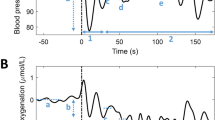Abstract
Objective. Blood pressure is usually measured noninvasively with a cuff on the arm or the leg. Circumstances exist, however, when an alternative site for blood pressure measurement is desirable. This study is designed to identify a location on the forehead where blood pressure can be reliably measured noninvasively.Methods. We mapped the superficial temporal artery and/or the supraorbital artery in 65 volunteers and found a rectangular area where an adhesive pressure pad could be placed over each artery. Oscillometric signals were recorded from four different locations over the forehead in 19 of the 65 volunteers to compare the amplitude of the signal and mean blood pressure between locations.Results. The course of the supraorbital artery is quite consistent. It passed through a 2.5-×1-cm rectangular area on the forehead in all volunteers in which it was mapped. The medial border of the rectangle is 0.5-cm medial and 1-cm above the medial corner of the left eyebrow. The course of the superficial temporal artery differed remarkably from person to person. We could not find an area of reasonable size to cover the artery in all volunteers. Mean blood pressures were the same in all forehead locations. The signal was the weakest on the center of the forehead and strongest directly over the superficial temporal artery.Conclusions. Our results show that the supraorbital artery, an end-artery of the internal carotid artery, which emerges through the supraorbital foramen and crosses the forehead near the center, is the preferred site to monitor blood pressure noninvasively on the forehead with an adhesive pressure bladder.
Similar content being viewed by others
References
Rowe MI. Physiologic monitoring—temporal artery. In: Gans SL, ed. Surgical pediatrics. New York: Grune and Stratton, 1973:188–189
Gauderer M, Holgersen LO. Peripheral arterial line insertion in neonates and infants: A simplified method of temporal artery catheterization. J Pediatr Surg 1974;9:875–877
Brown M, Gordon LH, Brown OW. Superficial temporal artery cannulation in adults. Anesthesiology 1984;61:114
Simmons MA, Levine RL, Lubchenco LO, Guggenheim MA. Warning: Serious sequelae of temporal artery catheterization. J Pediatr 1978;92:284
Prian GW, Wright GB, Rumack CM, O'Meara OP. Apparent cerebral embolization after temporal artery catheterization. J Pediatr 1978;93:115–118
Bull MJ, Schreiner RL, Garg BP, et al. Neurologic complications following temporal artery catheterization. J Pediatr 1980;96:1071–1073
Finholt DA. Superficial temporal artery cannulation is not benign. Anesthesiology 1985;62:93
Baker PD. Neural network processing of oscillometric waveforms and blood pressure estimation from the superficial temporal artery (PhD dissertation). Salt Lake City: University of Utah, 1990
Narus SP, Egbert TP, Lee TK, et al. An artificial neural network oscillometric algorithm for the temporal artery. Anesthesiology 1992;77:A549
Kobayashi H, Shimazu H, Kawarada A, et al. Indirect measurement of eye-level arterial pressure by volume oscillometric method. J Clin Eng 1990;15:195–204
Shenoy D, von Maltzahn WW, Buckey JC. Noninvasive blood pressure measurement on the temporal artery using the auscultatory method. Ann Biomed Eng 1993;21:351–360
Posey JA, Geddes LA, Williams H, Moore AG. The meaning of the point of maximum oscillations in cuff pressure in the indirect measurement of blood pressure. Part I. Cardiovasc Res Cent Bull 1969;8(1):15–25
Mauck GR, Smith C, Geddes LA, Bourland JD. The meaning of the point of maximum oscillations in cuff pressure in the indirect measurement of blood pressure II. ASME Trans Ser K J Biomech Eng 1980;102:28–33
Narus S, Egbert T, Lee T-K, et al. Noninvasive blood pressure monitoring from the supraorbital artery using an artificial neural network oscillometric algorithm. J Clin Monit 1995;11:289–297
Hertzman AB. The blood supply of various skin areas as estimated by the photoelectric plethysmograph. Am J Physiol 1938;124:328–340
Author information
Authors and Affiliations
Additional information
This study was supported, in part, by Innerspace Medical Inc., Irvine, CA, and by NASA's Rocky Mountain Space Grant Consortium. This study was presented, in part, at the 1994 Annual Meeting of the American Society of Anesthesiologists, San Francisco, October 15–19, 1994.
Rights and permissions
About this article
Cite this article
Lee, TK., Silva, F.H., Egbert, T.P. et al. Optimal sites for forehead oscillometric blood pressure monitoring. J Clin Monitor Comput 11, 298–304 (1995). https://doi.org/10.1007/BF01616987
Received:
Revised:
Accepted:
Issue Date:
DOI: https://doi.org/10.1007/BF01616987




